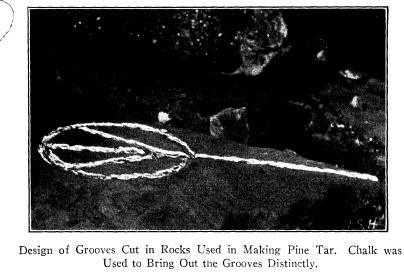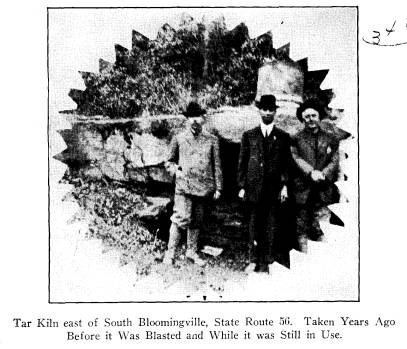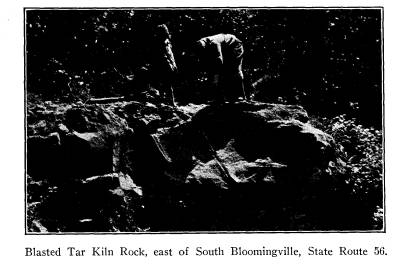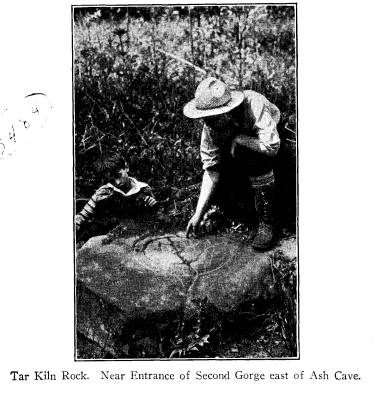Ohio History Journal
- 1
- 2
- 3
- 4
- 5
- 6
- 7
- 8
- 9
- 10
THE MAKING OF PINE TAR IN HOCKING
COUNTY
BY PASCAL A. BRIGHT
One of the primitive industries in
southern Ohio
where pine trees are found native was
the making of
pine tar. In the summer of 1929 in
company with Mr.
Emory Bainter, who then lived on Big
Pine Creek, Mr.
A. L. Burgess, of Columbus, whose
photographs have
done so much to help popularize the
state parks, and his
son, I was on a trip in the park region
of Hocking
County. We were in the hollow which
contains Sand
Cave, searching for marks left in the
rocks by the In-
dians. As we were going down the hollow
we came
upon a flat rock with well-defined
marks upon it, which,
however, were not such as we were
looking for, since
they had been made by the palefaces.
Mr. Bainter, who
is native to the region, was easily
able to satisfy curi-
osity and ignorance by giving the
information that the
stone was part of a kiln used in
extracting pine tar.
This particular stone was probably three
feet wide and
four feet long, coming to a blunt point
at one end. The
surface was possibly two and one-half
feet above
ground, and it bore a striking
geometrical figure, which
consisted of a circle and several
straight lines, all cut
into the stone an inch deep. The circle
was nearly
eighteen inches in diameter and one of
the lines ex-
tended along the diameter of the circle
and for more
(151)
|
152 Ohio Arch. and Hist. Society Publications than two feet beyond to the pointed end of the rock. Two other straight grooves joined the medial groove just inside the circumference of the circle at angles of near forty degrees. These grooves began in the cir- cumference. A photograph was taken. Unfortunately, the lines were chalked in order to make them distinct in the dense shade of the hollow. The lines are entirely |
|
|
|
too distinct and the grooves are practically lost in the chalking. The material from which to obtain the tar was abundant in an earlier day. It consisted of the hearts and knots of fallen pine trees from which the remainder of the wood had rotted away. The parts left were very durable, due to the great amount of pitch contained. The heart was split and cut up into pieces of small size. These with the knots were piled up inside the circle and |
|
The Making of Pine Tar in Hocking County 153 covered with an iron kettle whose rim fitted into the circular groove. Then the rim would be sealed into the groove with mud, and the long draining groove would also be sealed with mud leaving a tubular channel. A fire was then built about the kettle; the tar was thus roasted out to flow along the draining tubes to a recep- |
|
|
|
tacle below the pointed end of the stone. The price of the tar was about 40 cents per gallon. It is evident that the extracting of tar was rather widely practiced. Tar Hollow in Hocking County, Tar Kiln Cemetery in Fairfield County are reminders of the practice; and the writer knows of at least three other places including the one described above. |
|
154 Ohio Arch. and Hist. Society Publications Some months after the discovery in Sand Cave hol- low the writer was in the home of Mr. Byron L. Cave of Lancaster. Conversation brought out the fact that about 1912 he had secured a photograph of a tar kiln that was then operated. This kiln was about one mile east of South Bloomingville on what is now State Route 56. This kiln did not have a surface drainage but a hole had been drilled through the rock and the tar was |
|
|
|
collected beneath. When Route 56 was improved this rock was blasted to make the road wide enough. The break was along the line of the drain-tube and it may easily be seen now at the left side of the road between South Bloomingville and Ash Cave. Pine tar was formerly peddled among the farmers in the regions north of where it was produced. It was used as a sort of salve on wounded domestic animals. It was also put on the noses of sheep twice a year to |
The Making of Pinc Tar in Hocking
County 155
keep away the bot-fly which laid its
eggs in the nostrils
of the sheep. The larvae from these
eggs developed in
the frontal sinuses of the sheep
causing death. An-
other use was in the greasing of farm
machinery, the
axles of wagons, etc. Of all this the
words "tar-bucket"
are suggestive.
Perhaps a few words as to evergreen
trees in Hock-
ing County may well be added. The
hemlock grows
best in the hollows and canyons.
Magnificent specimens
are numerous. The cedar is not so
numerous. The
most numerous and largest specimens
known to the
writer are just east of Ash Cave. There
are three kinds
of pine, pitch-pine (Pinus rigida), the
scrub- pine (Pinus
virginiana), and the short-leafed pine (Pinus echinata).
These are common in the Hocking County
park region.
The largest pine the writer has seen in
the county is a
short-leafed pine on the edge of the
cliff near the steps
that lead down to the Rock House. It is
a magnificent
tree easily one hundred feet high.
AN ORIGINAL CONSERVATIONIST
On October 19, 1930, the following news
item under
a Logan dateline appeared in the Athens
Messenger:
"George F. Bareis, vice-chairman
of the Ohio State
Archaeological Society, during his
conversation at Old
Man's Cave Friday, gave much credit to
the Rev. Pascal
A. Bright of Pomeroy for the
development of the Hock-
ing Scenic District into a state park.
He recalled having served with Mr.
Bright on a
state committee many years ago which
had for its pur-
pose the procuring of options on a
portion of land in
the Old Man's Cave region. This was the
initial step,
|
156 Ohio Arch. and Hist. Society Publications he said, which finally led to the State's acquiring the land. Mr. Bareis also credited Mr. Bright with being one of the most enthusiastic boosters of the Hocking County parks since they have been opened. . . ." |
|
|
|
Pioneering is always interesting. This is a story of pioneering in publicity that has brought unantici- pated results. It is a story of independent effort, for no one else was working at it and the beginning was made on the pioneer's own initiative. After some time |
The Making of Pine Tar in Hocking
County 157
others became partners in the
enterprise but the begin-
nings were made by one person, the Rev.
Pascal A.
Bright, now of Pomeroy, Ohio, but a
native of Logan,
the county-seat of Hocking County. One
of the great-
est helpers in the project was The
Columbus Dispatch
which gave its columns in the interest
of an unselfish
public cause.
In the summer of 1915 Mr. Bright took
an extended
tour in which he visited, among other
places, two great
parks of the west: Muir Woods near San
Francisco
and Yellowstone National Park. The
following sum-
mer he visited again the scenic region
of Hocking
County and was impressed with the fact
that right here
at home was beauty and grandeur that
needed only
advertising to become famous. The big
trees are singu-
larly suggestive of the bigger ones in
Muir Woods; and
the canyons with their silent
"cathedral gloom," their
fern covered and colored walls are
impressive even to
travelers who have seen vaster ones.
In the Western Christian Advocate (official
organ
of Ohio Methodism) of August 15, 1917,
there appeared
a full-page article by Mr. Bright,
descriptive of the park
region, in which the following is the
concluding sen-
tence: "Of such unusual interest
and beauty is this
region that we hereby move that it be
made a state park
for the benefit and "enjoyment of
all the people." So
far as is known to Mr. Bright this is
the first suggestion
in print that such parks should be
established in Hock-
ing County.
Here the matter rested for several
years, but an
editorial in The Columbus Dispatch about
1922 on state
parks induced him to write to the
"Mail Bag" a letter
158 Ohio Arch. and Hist. Society
Publications
concerning the Hocking County region.
Much to his
surprise the letter did not appear in
the "Mail Bag" but
portions of it were worked into a
two-column article
several inches long with big head-lines
in a Sunday
edition. The next step was the
interesting of the clubs
in Logan in the establishment of the
parks. A cordial
response was made by several clubs and
he was, in time,
invited to address the Kiwanis Club on
the subject.
Mr. Bright thought he sensed an
intention on the part
of the state authorities to do just
what he was desirous
of having done, so he kept writing
letters to the Dispatch.
These were all published and attracted
more or less
attention, as was evidence by inquiries
that came to him.
Then about 1925 the first purchases
were made and the
parks became a realization.
Mr. Bright claims no knowledge as to
how the deter-
mination on the part of the state
authorities began or
who was the prime mover. But about this
time, through
a friend, Mr. Henry Becker, of the
Auditor of State's
office, a very pleasant acquaintance
was made with the
Auditor of State, Mr. Joseph T. Tracy.
He was much
interested in the whole matter and had
large hopes for
securing extensive tracts in Hocking
County.
Letters appeared and still continue to
appear in the
Dispatch. Several years ago through these letters an
acquaintance was formed with Mr. A. L.
Burgess of
Columbus. Mr. Burgess proved to be a
valuable ally
in the promotion business, for he is an
expert amateur
photographer. He has made dozens of
photographs,
some of which have had wide publicity.
The parks have
no more frequent visitor or warmer and
more helpful
friend.
The Making of Pine Tar in Hocking
County 159
At last came the big opportunity. In
the winter of
1928 Governor Donahey appointed a
committee to
launch a "Know Ohio Week." At
one of the committee
meetings Mr. Bright became an observer.
He discov-
ered that very influential interests
were promoting the
"Week," and had their plans
ever borne fruit a very
interesting story could be written
about them. Besides
learning what was in the air the most
that he got was
cold shoulder. However, he did learn that
the psycho-
logical moment had come for Hocking
County. The
attention of the State had been caught
and parks were
a portion of the picture that was to be
presented. Senti-
ment in Hocking County already existed
and it took no
urging to obtain results. The Logan
Chamber of Com-
merce, the Kiwanis and Rotary Clubs
published an illus-
trated folder containing a map and
descriptive matter.
The edition, of 10,000 copies, was
widely distributed.
In advance of "Know Ohio
Week" Mr. Bright sent
long letters to selected newspapers in
several parts of
the State. At least one of these
letters was published,
for it was repored having been read in
an Akron paper.
For several years the crowds of
visitors had been
growing and forest rangers had been
stationed at Old
Man's Cave and the Rock House. The Rock
House
had been having a good many visitors
for many years.
When the ranger made his first report
for Old Man's
Cave for 1927, there had been more than
13,000 visitors.
At the Rock House in 1927 there were
about 18,000
visitors. But when the reports were
made for 1928,
the year of the "Know Ohio
Week," attendance at Old
Man's Cave had jumped to nearly 30,000,
and to about
22,000 at the Rock House, in spite of
miserable roads.
160
Ohio Arch. and Hist. Society Publications
Concerning "Know Ohio Week,"
it was said at the
meeting of the Ohio Petroleum
Marketer's Association
the next winter that Hocking County was
the only
county in the State that went
"over the top." By this
time publicity was going of its own
momentum. Illus-
trations and articles appeared until
almost nation-wide
attention had been secured with almost
no additional
cost. The crowds kept coming so that
the rangers at
three points for 1929 reported more
than 117,000 visits,
as against 52,000 the previous year. In
1930 at the
Rock House there were 54,814 visitors,
of whom 4,820
were from 31 different states; at Old
Man's Cave there
were 87,127 visits, of which 2,380 were
made from 40
different states including 32 from
Ontario, and one from
the Hawaiian Islands. There were more
than 60,000
visits reported at Ash Cave for 1930.
What is claimed for Mr. Bright is that
his vision
of what would come to pass in Hocking
County has
been sufficiently justified. He started
something big.
He has been a leader in discovering to
the people of
Ohio the finest bit of out-of-doors in
the state, where
many profitable and pleasant hours may
be spent free
from the drawbacks of a pleasure resort
conducted for
profit. The people continue to come
because the parks
speak so eloquently for themselves.
Publicity has drawn
people across the continent to see
attractions in the West
that are relatively not one whit finer
than are to be seen
close to home at a very small cost.
It would be almost unjust to close this
article with-
out the mention of Mr. Frank Blasius,
Mr. R. R. Lan-
ning and Representative L. P. Mooney,
who with others
have done major work in Hocking County.
THE MAKING OF PINE TAR IN HOCKING
COUNTY
BY PASCAL A. BRIGHT
One of the primitive industries in
southern Ohio
where pine trees are found native was
the making of
pine tar. In the summer of 1929 in
company with Mr.
Emory Bainter, who then lived on Big
Pine Creek, Mr.
A. L. Burgess, of Columbus, whose
photographs have
done so much to help popularize the
state parks, and his
son, I was on a trip in the park region
of Hocking
County. We were in the hollow which
contains Sand
Cave, searching for marks left in the
rocks by the In-
dians. As we were going down the hollow
we came
upon a flat rock with well-defined
marks upon it, which,
however, were not such as we were
looking for, since
they had been made by the palefaces.
Mr. Bainter, who
is native to the region, was easily
able to satisfy curi-
osity and ignorance by giving the
information that the
stone was part of a kiln used in
extracting pine tar.
This particular stone was probably three
feet wide and
four feet long, coming to a blunt point
at one end. The
surface was possibly two and one-half
feet above
ground, and it bore a striking
geometrical figure, which
consisted of a circle and several
straight lines, all cut
into the stone an inch deep. The circle
was nearly
eighteen inches in diameter and one of
the lines ex-
tended along the diameter of the circle
and for more
(151)
(614) 297-2300



